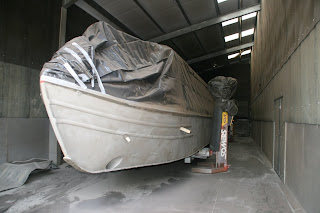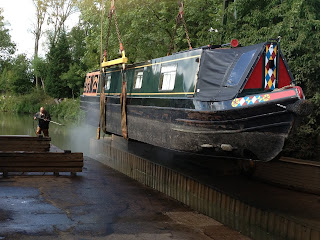Dust Extraction equipment Debdale Wharf
In my last post about grit blasting I showed an image of the first boat through the facility. Above is an important part of the facility that is not normally in full view, the dust extraction equipment.
Albert with the cabin sheeted-up and hull without any bitumen coat
Albert went into the grit blasting bay yesterday and was treated this morning. I went up to Debdale this afternoon to inspect the hull once it was bare. It is revealing to see how she has stood up to almost 20 years in the water. Mike Goode took me over all the areas treated and, although there was some pitting along the water line, she appears to have stood up well.
Bare hull sides with some signs of pitting
Anodes removed so area behind can be treated
Stern and Rudder
Tomorrow Albert moves into another bay in the building for treatment. The hull up to the rubbing strip will be coated with a two-pack epoxy resin coating and then the gunwales and counter will be painted. The red band on the counter will be reinstated but the paint will be applied over the epoxy base. There are also some extra jobs to be carried out whilst she is out of the water. The gas locker base and bulkhead will be treated with epoxy, because Albert has a wet locker, and we are having the bottom rudder bearing replaced since it has been groaning for a few years (like the crew!).






























